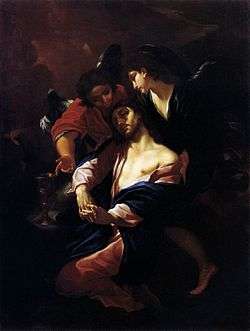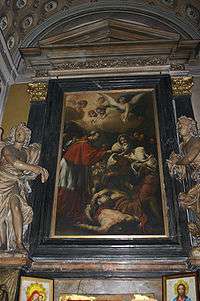Giacinto Brandi
| Giacinto Brandi | |
|---|---|
| Born |
1621 Poli, Lazio |
| Died | 19 January 1691 |
| Nationality | Italian |
| Known for | Painting |
| Movement | Baroque |
Giacinto Brandi (1621 – 19 January 1691) was an Italian painter of the Baroque era, active mainly in Rome and Naples.

_-_Dome_HDR.jpg)

| Wikimedia Commons has media related to Giacinto Brandi. |
Biography
Born in Poli, in Lazio, he was trained in Rome in the studio of Alessandro Algardi, a noted sculptor, who noted that Brandi was more suited to painting. He joined the studio of Giovanni Giacomo Sementi. He traveled to Naples from 1638, and by 1647 had returned to Rome to work under Giovanni Lanfranco, where Brandi befriended Mattia Preti. The two latter artists would often collaborate.
His works are well distributed among baroque Churches of Rome including San Carlo al Corso ceiling frescoes (1670–1671), San Silvestro in Capite, Sant'Andrea al Quirinale, a canvas of Sant'Andrea (1650) in Santa Maria in Via Lata, a painting of Martyrdom of the Forty (1660) for the Chiesa delle Santissima Stimmate di San Francesco, a Coronation of the Virgin (1680) which serves as main altarpiece for the church of Gesù e Maria, a canvas of the Drunkedness of Noah in the Galleria Corsini, an Assumption (1655) for Santa Maria in Organo in Verona, a fresco from Ovid's Metamorphoses (1651–1653) for Palazzo Pamphilj in Piazza Navona, and a Martyrdom of San Biagio for San Carlo ai Catinari. In 1647, he joined the Congregazione dei Virtuosi al Pantheon in Rome and from 1651 was inducted into the Accademia di San Luca for painters. In 1663, he frescoed the life of Saint Erasmus for the crypt of the cathedral of Gaeta. Some of his works are in Milan, Toledo, and Zaragoza.
Among his pupils were Carlo Lamparelli of Spello,[1] and Alessandro Vassello.[2]
References
- ↑ Orlandi, Pellegrino Antonio; Guarienti, Pietro (1719), Abecedario pittorico, Naples, p. 105
- ↑ Orlandi page 51.